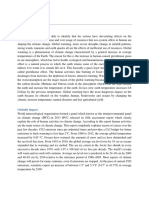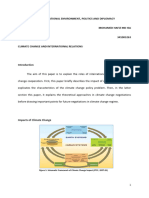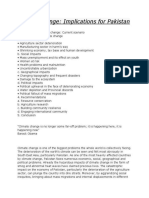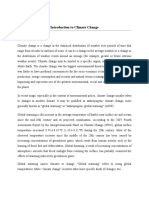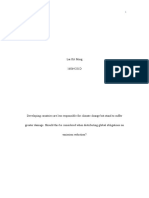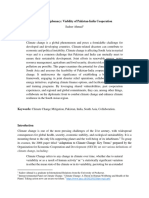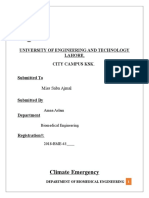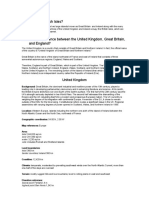The term Climate Change has many definitions one of which is “A long-term change in the typical or
average weather of any region”. Global warming is also an indicator of the Climate Change. As the
carbon dioxide and greenhouse gasses tend to encapsulate the heat in the atmosphere, these lead to
global warming. The emissions of carbon dioxide have increased by 40% ever since the onset of the
industrial revolution in the 1700s. The rise in the greenhouse gases has ultimately resulted in the global
warming. Studies have revealed that the greenhouse gases also contribute to the depletion of the ozone
layer, which is the layer of ozone. To understand ozone layer, one should be able to understand the
structure of earth and its various parts, such as Earth's stratosphere and that is important for absorbing
most of the Sun's ultraviolet radiation. That is, one of the fundamental role of ozone layer is that, it
helps in repelling the ultraviolet radiations from the sun. Across the globe, decreasing snow covers,
rising sea levels, melting glaciers, extreme weathers, floods and droughts have convinced people and
policymakers that Climate Change threat is real, and it will be catastrophic if no actions are taken to
minimize the damage caused by it. Global sea level has risen 6.7 inches in the last century, and the rate
has doubled in the last decade. Sea ice in Antarctica and Arctic is declining continually
They physical determinants of the climate change are human established industrial areas and other
human activities are the dominant causes of Climate Change. However, natural divers such as changes in
energy from sun and the cooling effect of volcanic eruptions have small net effect on the climate
change.
. The principal well-mixed greenhouse gases which are carbon dioxide, Methane and Nitrous oxide
which have atmosphere lifetime of decades or more are the greater contributor to climate change. CO2
emissions sources are cement manufacturing, fossils fuel combustion and land –use change from
activities such as deforestation. When finished cement is carbonized sink of atmospheric CO2 is
produce. In the industrial era, the CO2 atmospheric growth rate has been exponential; Over the last 50
years, CO2 has shown the largest annual RF (radio Frequency) increases among all GHGs
Climate Change poses a grave threat to Pakistan. Pakistan being one among the developing countries is
endangered by this threat mainly to its socioeconomic and agricultural sector. Pakistan is an Agro-based
economic country, which means that water scarcity causes an alarming situation for the country. Water
scarcity hampers the food supply which in turn affects the economy of the country.
Due to rise in global temperature, the chance of rainfall will increase. Ascribed to more rainfall and
melting of the glaciers, the Indus River will fail to accommodate more water. As a result, floods will
occur rapidly. They will damage the crops and reduce agricultural production. Furthermore, they will
cause some infectious diseases in not only human beings but in animals also. Resultantly they will
disturb the livestock and the birds. Also, the sea level will rise which will cause sea intrusion in the
coastal areas of Sindh. It will affect the growth of mangrove forests. Similarly, salinity of this ground will
increase which will convert the fertile land into barren land.
In Pakistan 5000, glaciers are retreating faster than anywhere else in the world, threatening Indus River
flows. The pace of deforestation is rampant in Pakistan, and annually the country losses 4-6 percent of
its precious forests
�Pakistan introduced its first policy on climate change in the year 2012 known as National Policy for
Climate Change (NPPC). The ministry of climate change officially declared it in 2013. Its main theme is
adaption to the climatic conditions. The policy focuses on the different variable of climate change
Critically evaluation of climate policies adopted in Pakistan
Pakistan government adopted first climate policy in 2012, when first National Policy on Climate Change
came into action in response to high variations in the climatic conditions of the economy. The policy was
focused on key sectors of economy, where energy, food, water, and health were the most important
issues against Climate Change in Policy document. The policy provided adaptation against rising
temperature, flooding and extreme weather conditions. Adaptations against Climate Change in
agriculture sector includes changing in cultivation time by the farmer community, addition of extension
worker in the farmer services, and the protection walls constructed to reduce the land erosion and save
the fertile land surface. These strategies were adopted in agriculture sector. Hybrid seeds and effective
drip irrigation system was used to tackle the extensive need of water in agriculture sector. Drip irrigation
system improves the water use at field and reduced the losses of water due to in efficiency of canal
water system. During the times of droughts, the drip water system can help to keep the crops green by
providing it continuous supply of water and minerals. Pakistan has adapted various options to reduce
the impact of Climate Change on health, where certain health problems are associated with changing
climate and Pakistan has an eye over it in terms of regulating the health policy aligned with Pakistan
changing climate.
Considering the forest sector policy against Climate Change. It is quite a vibrant policy that can have a
significant impact on the reversible impact of Climate Change; 1 Billion trees plantation has increased
the forest cover of Pakistan by 2 %. This Policy is the best adaptation Policy against climate for long run
restoration of forest and greenery in the economy of Pakistan. Temporary migrations against coasted
sea level rise are one of the local government adaptation policies against Climate Change.
The weakness of Pakistan is on the institutional level, which restrict Pakistan’s readiness against Climate
Change. Because none of the Climate Change policies has ever been 27 practically well planned that can
restore the impacts or can reduce the impacts on poor people of Pakistan. Migration against climate
change need housing projects, which can help people of coastal regions to access low budget houses
and projection against Climate Change migrations.
It is observable in Pakistan that policy actions are always facing certain challenges and restriction to get
in to the mainstream of the human life across all the Provinces and Districts. Ineffectiveness of policy
can be explored in two dimensions, where one is implementation issues and second encounters the
acceptability issues in policy design. Implementation issue are associated with structure of government
and state laws and regulations, corruption and lack of well to act upon the basic requirements to sustain
in the competitive world. In Pakistan, the duration of government for a party is only 5 years, which is not
�in favor of governing party to implement long-term policies and Climate Change is one the most
important long-term policy-oriented phenomenon. This creates a gap in policymaking and
implementation. Second is the problem acceptability issue of a policy for some communities, where
government implements it for welfare of economy and local forest holders do not accept the ban on its
cutting and influencing, sometime locals are dependent on forest and government restrict them for
using it, which creates a gap in policy implementations and corrections against Climate Change in
Pakistan. Other issues of policy ineffectiveness lie after the announcement of a ban or policy, which
encounters the issues of monitories, evaluation and expertise, which can improve it, further.
Pakistan is a developing country, which might face the problems of financing against the impacts
received by the local farmers and forest stakeholders. Climate Policies in Pakistan can help the world by
protecting the pristine environment of the earth but incentives and correct policy actions with proper
implementation needs financial support. If the country is supported well and monitored well in terms of
climate funds, it believes 28 the Policy ineffectiveness in Pakistan can be reduced to level of its efficiency
for mitigations and adaptation against the changing climate. None of the policy is workable until some
incentives or penalties are associated to turn on the behavioral changes in the targeted communities.
many conventions and accords are signed in the hopes of improving the dilemma of weather changes.
The first amongst there is from the UN, which is the UNFCCC (United Nations framework convention on
climate change). It was adopted in 1992 and became effective in 1994. UNFCCC has always played its
role and regular reports regarding the climatic changes. The Kyoto protocol (1997) assigned limited
number of emission targets, which would have been highly effective if the US had ratified it. Special
�Climate Change Fund (SCCF) and Least Developed Countries Fund were established in 2001 at
Conference of Parties7 (COP). UN has never ceased negotiations on different platforms. The Paris Accord
came into force in 2016 ratified by 55countires.Nonetheless; it is evident from the surroundings that
Climate Change has wreaked havoc on human life. Despite these, some countries around the globe do
not understand the gravity of this issue



